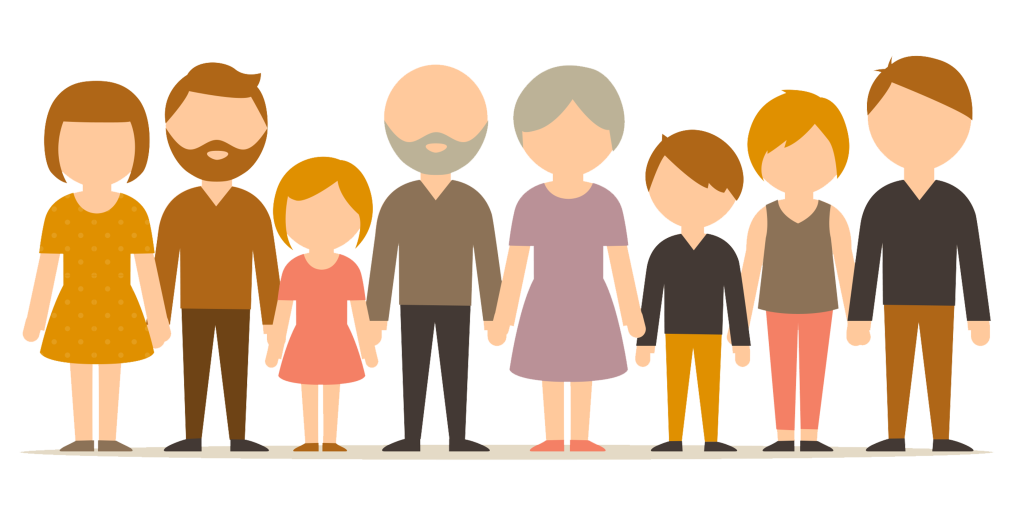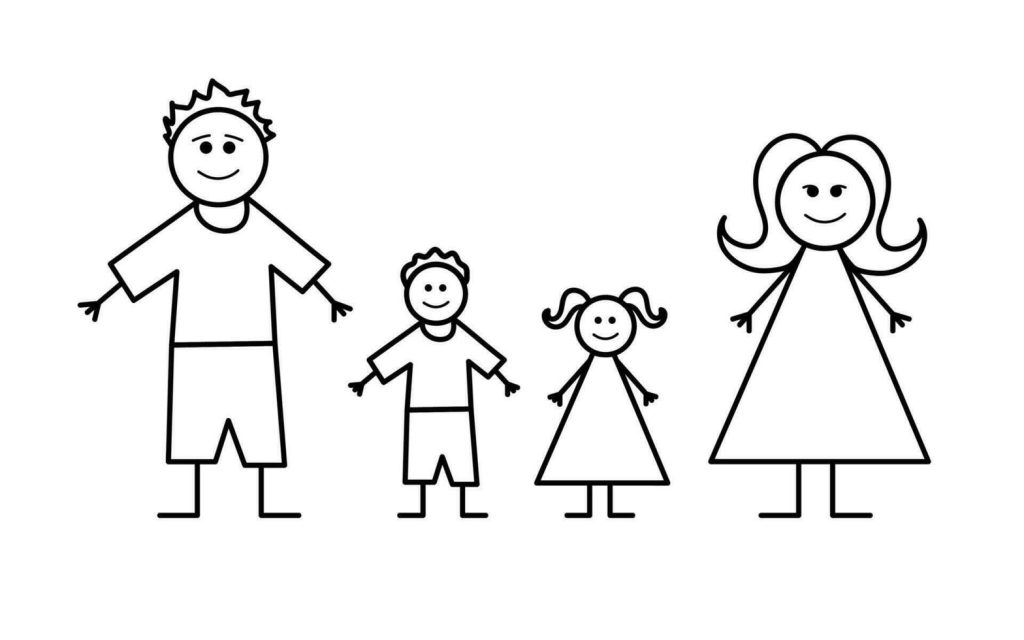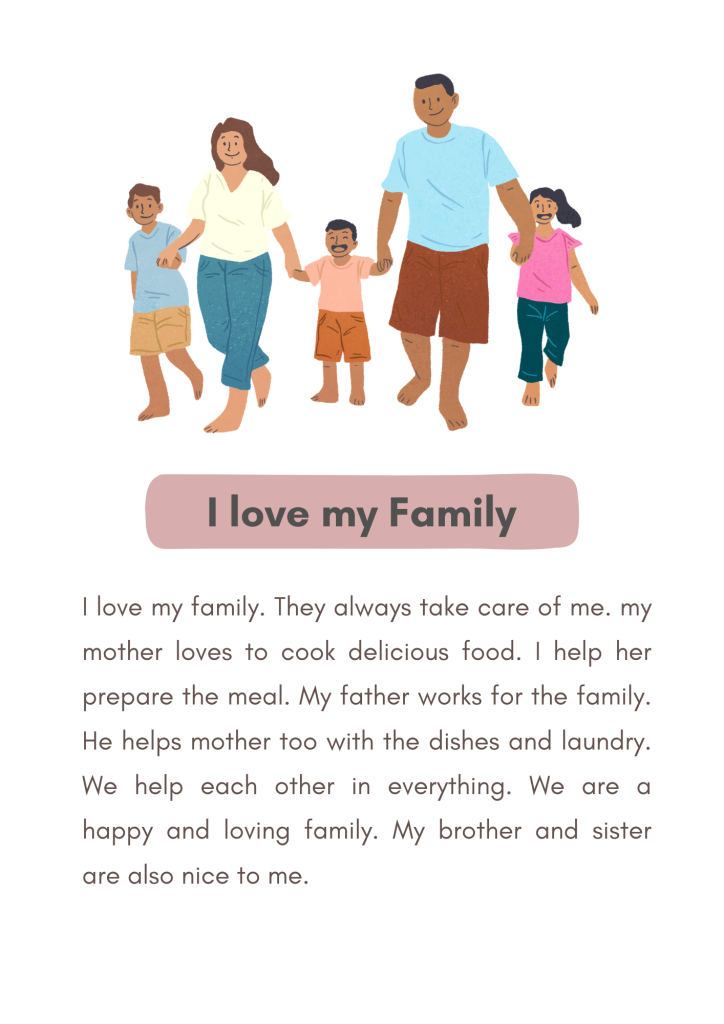9 Beginner – My Family
Ronna Marie Nogalo
Chapter 4:
Learning Objectives
At the end of the lesson, student must be able to:
- Introduce family members using simple, structured sentence in the target language.
- Describe family members’ job roles and responsibilities through peer sharing exercises; and
- Create a basic short story about family, demonstrating simple sentences and vocabulary.
Vocabulary
- Family – a group of two or more people who have a connection through marriage, birth, or adoption and often reside in the same household.
- Educators – a person imparts values as well as abilities.
- Short Story – a fictional prose narrative that is often focused on a small number of characters and is shorter than a novel.
- Flash Fiction – a fiction fewer than 1,000 words
- Micro Fiction – a fiction that is less than 300 words
Essential Knowledge

https://www.transparentpng.com/
Social scientists believe that family is the most fundamental social unit in human life, offering psychological support, security, and a sense of belonging. A family, on the other hand, is a group of two or more people who have a connection through marriage, birth, or adoption and often reside in the same household. Families can be different, from traditional to modern types, but what makes a family special is the love, care, and respect members have for each other. Despite conflicts and stress that can occur, a healthy family unit overcomes these obstacles, emerging stronger and more adaptable. Additionally, recognizing your family’s jobs and responsibilities is critical, since they create the foundation of your sense of self and individual growth. Finally, a family provides an important source of stability and convenience, affecting not just its members’ psychological well-being but also how well they deal with everyday challenges. Thus, a strong family foundation is essential for raising children who can form significant relationships and make contributions to society.
Activities
General Instructions: Please read the activities carefully and follow the directions provided in each exercise. These activities are designed to enhance your communication and writing skills in the target language. Pay attention to details, and take your time to complete each task thoughtfully. Focus on expressing your ideas clearly and accurately
Conversational (Family Introductions)
Activity 1: Introduce your family
Instruction: In a ten (10) minute activity, draw your family on a sheet of paper, representing all the members of your family. After completing the drawing, use the sentence frames provided to describe each family member by filling in the blanks. Once you’ve finished, present your drawing and descriptions to the class.
Example drawing of a family:
 Example sentence:
Example sentence:
This is my father. His name is Ronel. He is 50 years old. He likes to play basketball.
Below is a basic sentence frame to guide you:
This is my (Family member). His/Her name is (Name). He/She is (Age) years old. He/She likes to (Activity).
Take Note:
Pronouns
He/ His– Boy
She/ Her– Girl
Now it’s your turn!

Technical (Peer Sharing: Family Jobs and Roles)
Family jobs and roles are the different tasks family members do to help each other and take care of the home. These roles can include earning money, taking care of daily needs and feelings, and teaching values and skills. Family members often set examples, affect each other’s behavior, and provide support during hard times. Solving problems and keeping family traditions are also important tasks that help family bonds. Together, these jobs create a caring environment where everyone’s efforts help the whole family.
Activity 2: Peer Sharing
Instruction: For the peer sharing activity, start by choosing a partner. Once paired up, spend the next 5 minutes interviewing your partner about their family members’ jobs and responsibilities within their household, using the guide questions provided. As your partner answers, write down their responses. After the interview, you and your partner will present what you have learned to the class. Each pair will have two minutes to share their findings.
Guide Questions:
Creative (Writing a Short Story about Family)
A short story is a made-up story that is shorter than a novel and usually focuses on a few characters (Hansen, 2024). Short stories are shorter than novels. If a story is less than 1,000 words, it’s called “flash fiction,” and if it’s under 300 words, it’s “microfiction” (Blurb blog, 2024). Christopher Walking (2024) says short stories don’t have complicated plots, but they are intense. Here are the key features of a short story:
- Characters – In short stories, the number of characters is typically limited. They will feature a primary character or protagonist who you will encounter at an important point in his or her life.
- Narrator – the narrator should not be confused with the author. In a short story, the narrator is the one who tells the story. Narrators in short stories are entirely fictional.
- Setting – because short stories are limited in length, having many settings is uncommon. A setting refers to the period and location where the story’s events occur.
- Events – events are the facts in a story that shape the plot and drive the action forward. The storyline is defined as the order and presentation of the events by the narrator.
- Closure – a closure is the point at which the story ends. If it resolves the story’s problem or issue, it marks the end. If the situations remain unresolved, the conclusion is called open. In this instance, the short story concludes with a climax.
Here is an example of a short story:

YouTube.com
Activity 3: Writing a Short Story
Instruction: Write a short story of at least 4–5 sentences about a typical day in your family’s life. Describe what each family member does throughout the day, using simple present-tense sentences. You will have 5–10 minutes to complete this task. Once you’re finished, please submit your work to your teacher.

Let’s Check!
INSTRUCTION: Read each statement carefully and fill in the blank with the correct answer.
Key Takeaways
- Family is important to understand since it determines who we are, our beliefs, and our behaviors. When we think of family, we consider our roots, relationships, and the many responsibilities that each individual performs. This allows us to form stronger bonds and better understand each other.
- Understanding family relationships may also reveal how they influence our choices and actions. By thinking about family life, we appreciate both the love and the challenges that help us grow.
- Generally, activities like introducing your family, sharing their roles, and writing stories about them help you understand what family means. Through family discussions, you will build speaking, technical, and creative skills while deepening your emotional understanding of family.
